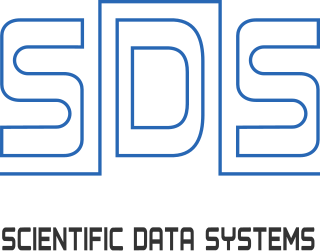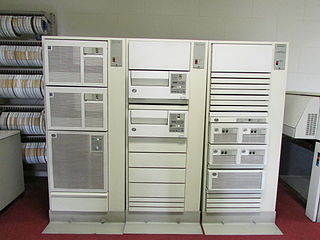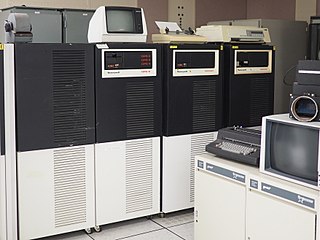
A mainframe computer, informally called a mainframe or big iron, is a computer used primarily by large organizations for critical applications like bulk data processing for tasks such as censuses, industry and consumer statistics, enterprise resource planning, and large-scale transaction processing. A mainframe computer is large but not as large as a supercomputer and has more processing power than some other classes of computers, such as minicomputers, servers, workstations, and personal computers. Most large-scale computer-system architectures were established in the 1960s, but they continue to evolve. Mainframe computers are often used as servers.

A minicomputer, or colloquially mini, is a type of smaller general-purpose computer developed in the mid-1960s and sold at a much lower price than mainframe and mid-size computers from IBM and its direct competitors. In a 1970 survey, The New York Times suggested a consensus definition of a minicomputer as a machine costing less than US$25,000, with an input-output device such as a teleprinter and at least four thousand words of memory, that is capable of running programs in a higher level language, such as Fortran or BASIC.

In computing, time-sharing is the concurrent sharing of a computing resource among many tasks or users by giving each task or user a small slice of processing time. This quick switch between tasks or users gives the illusion of simultaneous execution. It enables multi-tasking by a single user or enables multiple-user sessions.
Control Data Corporation (CDC) was a mainframe and supercomputer company that in the 1960s was one of the nine major U.S. computer companies, which group included IBM, the Burroughs Corporation, and the Digital Equipment Corporation (DEC), the NCR Corporation (NCR), General Electric, and Honeywell, RCA and UNIVAC. For most of the 1960s, the strength of CDC was the work of the electrical engineer Seymour Cray who developed a series of fast computers, then considered the fastest computing machines in the world; in the 1970s, Cray left the Control Data Corporation and founded Cray Research (CRI) to design and make supercomputers. In 1988, after much financial loss, the Control Data Corporation began withdrawing from making computers and sold the affiliated companies of CDC; in 1992, Cray established Control Data Systems, Inc. The remaining affiliate companies of CDC currently do business as the software company Dayforce.
The GE-600 series is a family of 36-bit mainframe computers originating in the 1960s, built by General Electric (GE). When GE left the mainframe business the line was sold to Honeywell, which built similar systems into the 1990s as the division moved to Groupe Bull and then NEC.

The IBM System/370 (S/370) is a range of IBM mainframe computers announced as the successors to the System/360 family on June 30, 1970. The series mostly maintains backward compatibility with the S/360, allowing an easy migration path for customers; this, plus improved performance, were the dominant themes of the product announcement.
Systems Network Architecture (SNA) is IBM's proprietary networking architecture, created in 1974. It is a complete protocol stack for interconnecting computers and their resources. SNA describes formats and protocols but, in itself, is not a piece of software. The implementation of SNA takes the form of various communications packages, most notably Virtual Telecommunications Access Method (VTAM), the mainframe software package for SNA communications.

Wang Laboratories, Inc., was an American computer company founded in 1951 by An Wang and G. Y. Chu. The company was successively headquartered in Cambridge, Massachusetts (1954–1963), Tewksbury, Massachusetts (1963–1976), and finally in Lowell, Massachusetts (1976–1997). At its peak in the 1980s, Wang Laboratories had annual revenues of US$3 billion and employed over 33,000 people. It was one of the leading companies during the time of the Massachusetts Miracle.

The IBM 8100 Information System, announced Oct. 3, 1978, was at one time IBM’s principal distributed processing engine, providing local processing capability under two incompatible operating systems and was a follow-on to the IBM 3790.
Virtual Telecommunications Access Method (VTAM) is the IBM subsystem that implements Systems Network Architecture (SNA) for mainframe environments. VTAM provides an application programming interface (API) for communication applications, and controls communication equipment such as adapters and controllers. In modern terminology, VTAM provides a communication stack and device drivers.
DPCX was an operating system for the IBM 8100 small computer system. IBM hoped it would help their installed base of IBM 3790 customers migrate to the 8100 and the DPPX operating system. It was mainly deployed to support a word processing system, Distributed Office Support Facility (DOSF) which was derived from the earlier IBM 3730 word processing system.

The IBM 3790 Communications System was one of the first distributed computing platforms. The 3790 was developed by IBM's Data Processing Division (DPD) and announced in 1974. It preceded the IBM 8100, announced in 1979.

Scientific Data Systems (SDS), was an American computer company founded in September 1961 by Max Palevsky, Arthur Rock and Robert Beck, veterans of Packard Bell Corporation and Bendix, along with eleven other computer scientists. SDS was the first to employ silicon transistors, and was an early adopter of integrated circuits in computer design. The company concentrated on larger scientific workload focused machines and sold many machines to NASA during the Space Race. Most machines were both fast and relatively low-priced. The company was sold to Xerox in 1969, but dwindling sales due to the oil crisis of 1973–74 caused Xerox to close the division in 1975 at a loss of hundreds of millions of dollars. During the Xerox years the company was officially Xerox Data Systems (XDS), whose machines were the Xerox 500 series.
Plug compatible refers to "hardware that is designed to perform exactly like another vendor's product." The term PCM was originally applied to manufacturers who made replacements for IBM peripherals. Later this term was used to refer to IBM-compatible computers.
Edos is a discontinued operating system based upon IBM's original mainframe DOS. The name stood for extended disk operating system. It was later purchased by the West German computer company Nixdorf, who renamed it to NIDOS.

Hitachi Data Systems (HDS) was a provider of modular mid-range and high-end computer data storage systems, software, and services. Its operations are now a part of Hitachi Vantara.

The IBM 9370 systems are "baby mainframe" midrange computers, released 1986 at the very low end of, and compatible with System/370. The media of the day, referring to the VAX systems manufactured by Digital Equipment Corporation (DEC), carried IBM's alleged "VAX Killer" phrase, albeit often skeptically.

The Honeywell Level 6 was a line of 16-bit minicomputers, later upgraded to 32-bit, manufactured by Honeywell, Inc. from the mid 1970s. Honeywell literature for Models 6/06, 6/34 and 6/36 say "Series 60 ". In 1979, the Level 6 was renamed the DPS 6, subsequently DPS 6 Plus and finally DPS 6000.
CP-6 is a discontinued computer operating system, developed by Honeywell, Inc. in 1976, which was a backward-compatible work-alike of the Xerox CP-V, fully rewritten for Honeywell Level/66 hardware. CP-6 was a command line oriented system. A terminal emulator allowed use of PCs as CP-6 terminals.

The Honeywell Page Printing System (PPS) announced in 1974, is notable because it was the first commercially successful high speed non-impact printer. It could produce output at up to 18,000 lines per minute, where the earlier Xerox 1200 ran at 4000 lines per minute and the contemporary IBM 3211, ran at 2000 lines per minute. Most printer history has focused on the later IBM 3800 and the Xerox 9700.











